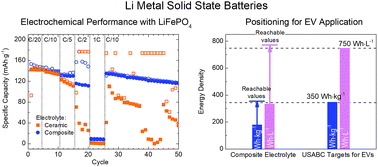当前位置:
X-MOL 学术
›
Sustain. Energy Fuels
›
论文详情
Our official English website, www.x-mol.net, welcomes your
feedback! (Note: you will need to create a separate account there.)
Will the competitive future of solid state Li metal batteries rely on a ceramic or a composite electrolyte?†
Sustainable Energy & Fuels ( IF 5.0 ) Pub Date : 2018-08-24 00:00:00 , DOI: 10.1039/c8se00273h Antonio Gutiérrez-Pardo 1, 2, 3 , Andrea I. Pitillas Martinez 1, 2, 3 , Laida Otaegui 1, 2, 3 , Meike Schneider 4, 5, 6 , Andreas Roters 4, 5, 6 , Anna Llordés 1, 2, 3, 7, 8 , Frédéric Aguesse 1, 2, 3 , Lucienne Buannic 1, 2, 3
Sustainable Energy & Fuels ( IF 5.0 ) Pub Date : 2018-08-24 00:00:00 , DOI: 10.1039/c8se00273h Antonio Gutiérrez-Pardo 1, 2, 3 , Andrea I. Pitillas Martinez 1, 2, 3 , Laida Otaegui 1, 2, 3 , Meike Schneider 4, 5, 6 , Andreas Roters 4, 5, 6 , Anna Llordés 1, 2, 3, 7, 8 , Frédéric Aguesse 1, 2, 3 , Lucienne Buannic 1, 2, 3
Affiliation

|
The industrial development of Li metal solid state batteries will be boosted not only by providing highly Li+ conductive electrolyte materials, but also by demonstrating their technical viability in the actual device. For the first time, the electrochemical performances of two different electrolytes, a pure Li7La3Zr2O12 ceramic and a polymer–ceramic composite, are compared in a solid state battery with a Li metal anode and a LiFePO4 cathode. No liquid or gel additive was added to improve the interfacial contacts. The technological viability of these two systems was assessed under realistic cycling conditions with a competitive cathode loading of 1 mA h cm−2. Here, we show promising performances for both electrolytes at 70 °C under slow cycling rates; however, the composite stands out under fast cycling rates due to enhanced interfacial contacts. The energy density of the two systems is compared to the electric vehicle industry targets providing clear specifications for future system development.
中文翻译:

固态锂金属电池的竞争未来会依靠陶瓷还是复合电解质?†
锂金属固态电池的工业发展将不仅通过提供高Li +导电电解质材料,而且通过证明其在实际设备中的技术可行性来得到促进。首次在具有Li金属阳极和LiFePO 4阴极的固态电池中比较了两种不同的电解质,即纯Li 7 La 3 Zr 2 O 12陶瓷和聚合物-陶瓷复合材料的电化学性能。没有添加液体或凝胶添加剂来改善界面接触。在现实的循环条件下评估了这两个系统的技术可行性,竞争性阴极负载为1 mA h cm -2。在这里,我们展示了两种电解质在70°C下缓慢循环速率下的有希望的性能。然而,由于增强了界面接触,该复合材料在快速循环速率下脱颖而出。将这两种系统的能量密度与电动汽车行业的目标进行了比较,为未来的系统开发提供了明确的规范。
更新日期:2018-08-24
中文翻译:

固态锂金属电池的竞争未来会依靠陶瓷还是复合电解质?†
锂金属固态电池的工业发展将不仅通过提供高Li +导电电解质材料,而且通过证明其在实际设备中的技术可行性来得到促进。首次在具有Li金属阳极和LiFePO 4阴极的固态电池中比较了两种不同的电解质,即纯Li 7 La 3 Zr 2 O 12陶瓷和聚合物-陶瓷复合材料的电化学性能。没有添加液体或凝胶添加剂来改善界面接触。在现实的循环条件下评估了这两个系统的技术可行性,竞争性阴极负载为1 mA h cm -2。在这里,我们展示了两种电解质在70°C下缓慢循环速率下的有希望的性能。然而,由于增强了界面接触,该复合材料在快速循环速率下脱颖而出。将这两种系统的能量密度与电动汽车行业的目标进行了比较,为未来的系统开发提供了明确的规范。











































 京公网安备 11010802027423号
京公网安备 11010802027423号